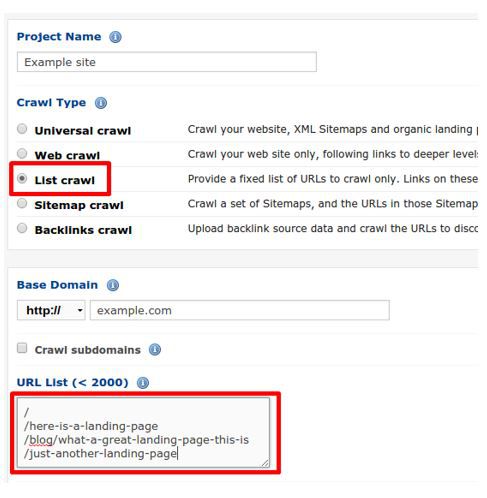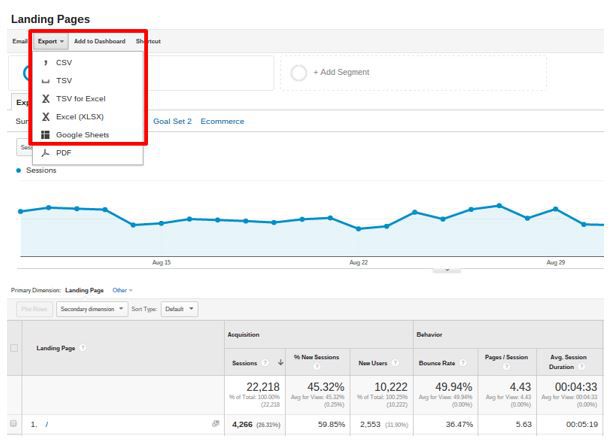Any page on your site has potential to become a user’s first port of call on your site, whether it’s optimized for new users or not. Potential customers could be entering your site to find empty pages, irrelevant content or even pages that you’d prefer to be hidden completely.
Which doesn’t exactly serve as the best first impression, and probably one that will cause them to bounce straight back to where they came from.

What’s more, these landing pages aren’t always easy to find in the normal day-to-day analysis of a larger site (because they might not be linked internally and won’t be found during a normal web crawl) which is why a detailed landing page audit should be part of your usual auditing schedule. This way you can be sure that your audience’s journey through your site gets off to a productive start.
Step 1: Export landing page data
Analytics
Assuming that every page on your site is tracked, Google Analytics (or your own choice of analytics software) should pick up the majority of landing pages from every source combined. It’s fine to just use this if you don’t have any other data available.
Download a list of landing pages plus engagement metrics (such as bounce rate, pages per visit and time on site).
Backlinks data
Download backlinks from the ‘Your most linked content’ report in Google Search Console (under ‘Links to Your Site’), and/or other sources such as Ahrefs, MajesticSEO and Open Site Explorer.
Crawl errors from Google Search Console and Bing tools
Anything a search engine is trying to crawl could be a potential landing page, and this data is free, so it’s worth including URLs from the Crawl Errors report (Crawl Information in Bing Webmaster Tools) in your audit to see if there’s anything that can be fixed.
Sitemaps, linked URLs and feeds
Anything you’re directing search engines and/or users to could end up as a landing page at some point. Ensure all URLs listed in your Sitemaps, feeds or internal links are included in your audit.
Remember that even a page that has been disallowed has the potential to be indexed in search results if it is linked to within your site or from an external source. Therefore it could still become a landing page.
The URL will still show in search results but Google won’t be able to see the content of the page so only a stripped-back version will show in results:
Sitelinks
Google loves to find inappropriate URLs and list them prominently in Sitelinks for your brand terms. Monitor this manually, or set up a report to analyze which pages are showing up for branded search terms.
Ranking tool SERP URLs
Using a rank reporting tool, export any URLs that are showing in search engine rankings.
Open Graph URLs
Extract all the Open Graph URLs listed on your site from a crawl to ensure these pages are optimized for social users.
Step 2: Crawl URLs with DeepCrawl and export
Paste the landing page URLs from the sources above into a List Crawl in DeepCrawl, or upload a file if there are more than 2,000 landing page URLs:

You can also identify empty pages – or pages that contain fewer results/products or less content – by adding custom extraction for number of results:

Export both the data from the normal List Crawl and the custom extraction data using a vlookup in Excel.
Step 3: Analyze and fix issues, such as…
Poor engagement
Sort your exported data by number of visits in Excel, then look for poor engagement. Pivot the data on number of results to see the effect.
When assessing how to improve engagement metrics on specific pages or templates, consider the traffic source and the needs of users on all devices. For example:
- Does the content serve the intent behind the keywords it ranks for? Is it immediately evident that the content will satisfy the user’s query?
- Does the Open Graph or Twitter Card information accurately reflect what is on the page? Be honest: have you used ‘clickbait’, which will encourage people to click through, but means they might bounce back once they’ve got what they wanted?
- Does the design of the content and/or date on the page make the content look fresh and up-to-date?
- Does everything work on mobile devices? Are your mobile pages being served to mobile users in search results (if not, check your mobile rel alternate and canonical tag set-up)?
- Are there clear, relevant calls-to-action on sales or conversion pages? Do the calls-to-action relate to the context of the page?
- Can pop-ups and interstitials be easily closed, especially on mobile devices?
- Does the page load in a reasonable amount of time, even when using mobile connections?
Misleading or undescriptive titles and descriptions
Analyze the titles and descriptions of your organic search landing pages. Make sure that what a user sees in the search result matches what they will get from the page and satisfies the same intent. This is also a good time to make sure these titles and descriptions are as engaging and optimized as they can be.
Tidying up any of these issues should increase click-through rate and reduce bounce rate, which could in turn help push these pages further up the rankings.
Non-200 status codes
Analyze any non-200 pages for potential redirects, and rectify the issue at the source. For example: change internal links to the canonical and primary version of a page.
Pay particular attention to quick fixes like 302/307 temporary redirects that can be changed to 301 permanent redirects, and bigger issues like 404s.
Organic entrances to canonicalized pages
If canonicalized pages are receiving organic search traffic, this might suggest that your canonical tags are not working properly. Use DeepCrawl’s Canonicalized Pages report (under Indexation in your report) to try and find the issue.
Intrusive pop-ups/interstitials
Intrusive pop-ups that block the user’s view of your page can affect engagement, which might then be reflected in the algorithms of the referring source.
In particular, Google has confirmed that they remove the mobile friendly tag and mobile ranking boost to webpages using ‘app-install interstitials that hide a significant amount of content on the transition from the search result page’.
Your landing page audit is a key opportunity to assess whether the content of your landing pages is being hidden by your pop-ups or interstitials in a way that could affect engagement (and therefore performance) on mobile and desktop screens.
Pages that shouldn’t be landing pages at all
Some pages just shouldn’t be used as landing pages, no matter what you do to them. These might include pages that you want to hide from public view, admin pages or empty categories. These should be dealt with appropriately using the correct implementation of:
- Redirects to send users and search engines to another place in the site.
- Canonical tags to send search engines to an equivalent
- Pagination to indicate sets of pages that should be treated as a group.
- Noindex / disallow to prevent search engines from indexing and crawling pages respectively.
- Parameter removal to indicate to search engines that they should ignore parameters.
Step 4: Analyze error pages
Sometimes error pages aren’t tracked with analytics, or aren’t tracked as errors. Tracking these is critical for finding out how many people land on error pages, and the URLs they land on.
As a final step to your landing page audit, pass the HTTP status code, and/or result counts for error pages into your analytic, then create custom reports for these pages to see how much traffic they receive.







